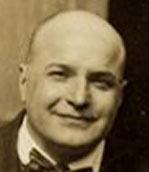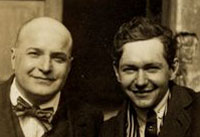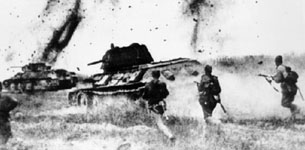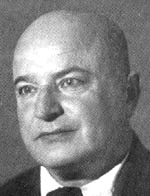Sinological Profiles
Vasili Alexeev
1881 - 1951Vasili Mikhailovich Alexeev, the leading figure in 20th century Russian Sinology, followed conventional lines of Western enthusiasm for Chinese literature, but took that tradition to a new level of maturity, and set new standards for the study of China in Russia.
He graduated from the Oriental Faculty at St Petersburg in 1902, and then continued his studies in England, France, and Germany. In Paris, his fellow students included Pelliot (to whom he felt especially close), Granet, and Maspero. He traveled in China during 1907, keeping a detailed and illustrated diary. He produced a study of Li Bwo's poetry and prose in 1911. His MA thesis on Szkung Tu's poems about poetry was published in 1916, and marked the beginning of his interest in Chinese literary criticism, a field in which he was a European pioneer, and in which, despite the ravages of politics, he continued to maintain an interest throughout his career.
1917 marked a certain watershed in Russian Sinology, and Alexeev was prompt to take a theoretical stand, with his article "On the Definition of Chinese Literature and the Present Tasks of its Historicization," which appeared in the Journal of the Ministry of Education for 1917. In this he recommended, not a sweeping theoretical approach, but the examination of particular cases (he mentioned the poet Tau Chyen as an example). From these known points, the larger social context could gradually be gradually apprehended. As with Ranke, he was willing to let the large movements speak for themselves out of the details. Methodologically, he argued for the criticism, rather than the passive acceptance, of Chinese attitudes toward Chinese literature and culture. This represented an advance in independence, in intellectual maturity, over the previous generation. Disciplinarily, he favored a coordination of effort between history, literature, philology, philosophy, linguistics, and art, all within Sinology. He also favored active cooperation between Sinology and other sciences. This proved to be an acceptable agenda, and Alexeev was thenceforth persona grata to the new dispensation. Though the Faculty of Oriental Studies was abolished as a separate unit in 1917, Alexeev became a Professor in 1918, and he and Ivanov were able to continue teaching.
Russian Sinology has two chief centers: St Petersburg, with its classical and humanistic emphasis, and Moscow, chiefly theoretical and contemporary. St Petersburg itself has two Sinological centers: the University, and the St Petersburg branch of the Institute of Oriental Studies, based at the Asian Museum and thus actually older (it was founded in 1818) than the Oriental Faculty of the University (founded 1854). In addition to his Professorship, Alexeev became the Curator and Senior Researcher at the Museum. In that role, he contributed a paper on Chinese folklore to a 1918 Museum symposium, published by its parent group, the Russian Academy of Sciences. Alexeev's situation at this time, though perilous like everybody else's, had great potential, which he quickly proceeded to realize. His position at the Museum gave him a realia basis: he had custody of artifacts for the study of Chinese popular tradition, including a large trove of Dunhwang documents brought back from a Russian expedition of 1914-1915. In 1919, Alexeev became associate editor, and chief of the Eastern division, of the newly founded Publishing House for World Literature. This provided a publishing outlet. Under his direction, the Museum's Sinological library was expanded, catalogued, and systematically employed in research, by a team of young persons Alexeev gradually gathered around him, among them the brilliant Shchutskii. Here was the nucleus of a major research effort. In parallel with the conventional classes at the University, the Museum mounted exhibitions and gave lectures, and thus was in contact with a wider public. The result, the confluence of all this, was something of a powerhouse, but of a type sufficiently proletarian in its aims and means to be acceptable to the harder minds at the center of things. Of this powerhouse, Alexeev was for long the guiding figure.
He wrote the chapter on Chinese literature in the compendium Literatures of the Orient (2ed 1920), and stressed the literary aspects, not exclusively the ideological aspects, of key figures. For example, he argued that Szma Chyen was primarily a stylist (and thus to an extent outside of doctrinal agendas) rather than an ideologue. Alexeev's Lyau-jai stories first came out in 1922 (Herbert Giles's version of the same material had appeared in 1908). He became a Corresponding Member, that is, an external member, of the Academy of Sciences in 1923. In 1924, another watershed year, St Petersburg officially became Leningrad. Sino-Soviet relations became ever more important during from the late 1920's. Among other things, this brought about an official interest in romanization and script questions. Alexeev, who achieved full membership in the Academy of Sciences in 1929, was among those deputed to look into the matter, along with Dragunov. He produced a report on The Chinese Hieroglyphic Script and Its Latinization in 1932, and an important paper on the Actor as Hero in Chinese History in 1935.
His research team was partly wiped out when several of its younger members, including Shchutskii, were arrested in early 1937. The Terror period was followed by the frantic distortions and re-alignments imposed by WW2. Alexeev himself survived, and retained his position, but intellectually, he went underground, writing but not publishing. He edited a symposium on China in 1940, but published nothing in the War years proper, and apparently spent much of his time during that period privately delving into the Wvn Sywaen.
With victory practically certain after Germany's military reverses in 1943, an organizational thaw occurred in 1944. The Oriental Faculty was restored at St Petersburg. Publication channels also opened up. Alexeev published a comparison of Horace and the Chinese critic Lu Ji in the Academy proceedings for 1944. A further study of "utopian monism," based on the writings of Su Shr's brother Su Sywn, appeared in Soviet Sinology for 1945. A probably expedient note was sounded with a poem by the Chinese patriot-poet Wvn Tyen-syang, which appeared in a 1946 issue of the Publications of the Military Institute for Foreign Languages. Alexeev's highly regarded modern Chinese-Russian Dictionary appeared in 1948.
Duyvendak took note of some of Alexeev's recent studies on Tang literature in a T'oung Pao article of 1947. But Alexeev's backlog of the war years remained largely a backlog. After his death in 1951, some of his unpublished works began to be printed. His 1907 China travel diary appeared in 1958, and studies of popular theater and painting in 1966. Much more apparently remains in manuscript. That particular part of Russian Sinological history remains unavailable to later Russian Sinology.
E Bruce Brooks
References
- L Z Eidlin (tr Francis Cleaves). The Academician V M Alexeev as a Historian of Chinese Literature. HJAS v10 #1 (1947) 48-52. A not unflowery 65th birthday tribute
- J J L Duyvendak. TP 38 (1947) 301-307
- Hartmut Walravens. V M Alekseev - Leben und Werk: Eine Bibliographie. OE v21 (1974) 67-95
- E Stuart Kirby. Russian Studies of China. Macmillan 1975
- L N Menshikov. Academician Vasilii Mikhailovich Alekseev (1881-1951) and His School of Russian Sinology, in: Europe Studies China (1995)
- Boris Riftin on Alexeev's Lyau-jai Jr-yi Researches
7 July 2004 / Contact The Project / Exit to Sinology Page



